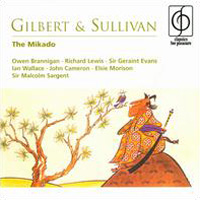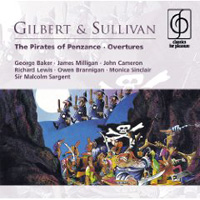 |
| September 1, 2008 Gilbert and Sullivan à la Mode
Why Savoy? Following their first collaboration, Thespis, introduced at the end of 1871 (and subsequently lost), Gilbert and Sullivan created the one-act Trial by Jury under a commission from the impresario Richard D’Oyly Carte to share a bill with the Offenbach opérette La Périchole. That work did so well that D’Oyly Carte commissioned and introduced more G&S works, and eventually built his own theater in which to present them. The Savoy opened with Patience in 1881; all the subsequent G&S works had their premieres there, and it was in that house that the performing tradition was developed. Hence, "Savoy operas," and the designation of those involved with them as "Savoyards." These works became popular everywhere. In the early 20th century Bruno Walter presided over productions of The Mikado in Berlin. In America there were performances in high schools as well as professional productions. By now, however, at least two generations here have grown up without much awareness of these marvelous entertainments, let alone any actual familiarity with them. The New York City Opera keeps some of the G&S works in its repertory, and in that institution’s former home, City Center, the determined ensemble called the New York Gilbert and Sullivan Players continues to perform this material with commitment, enthusiasm and a good deal of imaginativeness in spite of its limited resources. For the most part, however, we now rely on recordings to get to know and enjoy the Savoy operas, and the recordings offered have all, to a certain degree, borne the imprimatur of authenticity. In Britain, the D’Oyly Carte Opera Company recorded 11 of the Savoy operas on 78s for HMV back in the 1920s and early 1930s. The D’Oyly Carte, with some of the same singers, remade several of the works for Decca on LP, and into the stereophonic era. But, while the D’Oyly Carte retained exclusive British performing rights until 1961, there was no similar restriction on other forces’ recording the operettas, and thus it was that something remarkable happened at just the time stereophonic recording was getting up steam.
How well that worked is still a matter for discussion among committed Savoyards, some of whom have felt that even the finest operatic voices were not an adequate substitute for the Savoyard tradition. In general, though, the response to these recordings was so positive that they have never been out of the active catalog. The duet of Elsie Maynard and Jack Point in Act I of The Yeoman of the Guard is irresistibly effective as sung by the soprano Elsie Morison and the baritone Geraint Evans, both of whom sound as if they had treasured this piece all their lives (though neither had sung it before). The "Three Little Maids from School" trio, in The Mikado, exudes real spontaneity and charm through apparently instinctive resistance to camping it up. The men of the chorus are downright stunning in the March of the Peers, in Iolanthe, and the orchestra is always on its toes. Overall, Sargent distinguished himself throughout the cycle. Evans, as it turned out, sang in only the first three of these nine productions (Mikado, Gondoliers, Yeomen). In spite of his outstanding performances, he was said to have withdrawn from the project because he felt less than comfortable with the G&S idiom. His replacement, for the remaining six works, was the D’Oyly Carte veteran George Baker, who had recorded these works some 30 years earlier and was still unarguably authoritative but who did appear to be having a bit of a time here and there keeping up with the merciless tempo required in some of the patter songs. Elsie Morison, a leading soprano at Covent Garden at the time these recordings were made, has the lead female role in all nine works and is endearing in all of them. Among the other ladies are Heather Harper, Jeannette and Monica Sinclair, Marjorie Thomas, Doreen Hume, Elizabeth Harwood and Pamela Bowden. Among the men are the tenors Alexander Young and Richard Lewis, the baritones John Cameron and John Carol Case, and the Handelian basso Owen Brannigan. These recordings, issued individually on monophonic and stereophonic LPs (also on cassettes and open-reel tape), have recently appeared in their fifth CD edition. They were brought out in eight two-disc sets (with Trial by Jury in the same set as Pinafore) at full price in 1987, then reissued at mid-price in 1992, still in space-eating containers. There was a new edition in "slimline" jewel cases, sold only in HMV’s own shops in the UK, in 1998, and three years later we had the entire series in a single box of 16 CDs. The newest edition is on EMI’s economical Classics for Pleasure label, and is again in eight separate two-disc slimline sets, corresponding to the 1998 UK edition.
It must be said that the sound quality is not one of the strong points here. The original remastering for the first CD edition, in 1987, has apparently not been updated; it remains glassy and hard-edged, and often not very kind to the voices. Nonetheless, Sargent’s enthusiasm and commitment, and the fine response he drew from his singers and players, do come through, and such top-line recordings of these works are not likely to come our way again. It is even conceivable that this fifth CD edition may prove to be EMI’s final offering of this altogether remarkable series, and if the sound remains what it was, at least the packaging, documentation and pricing have been noticeably improved. . . . Richard Freed
Ultra Audio is part of the SoundStage! Network. |
 Gilbert and Sullivan: now there was a
productive partnership. The composer Arthur Sullivan (1842-1900) and his librettist
William Schwenck Gilbert (1836-1911) were not particularly close personally, but together
created a style of operetta, or "light opera," that might be regarded as a
British counterpart of Offenbach’s pre-Hoffmann stage works, but was, and
remains, utterly distinctive. With their marvelous tunes, clever parodies of grand opera,
witty texts satirizing customs and current events, and the famous "patter songs"
delivered at daunting speed by daredevil baritones, the droll "Savoy operas"
simply created a world of their own.
Gilbert and Sullivan: now there was a
productive partnership. The composer Arthur Sullivan (1842-1900) and his librettist
William Schwenck Gilbert (1836-1911) were not particularly close personally, but together
created a style of operetta, or "light opera," that might be regarded as a
British counterpart of Offenbach’s pre-Hoffmann stage works, but was, and
remains, utterly distinctive. With their marvelous tunes, clever parodies of grand opera,
witty texts satirizing customs and current events, and the famous "patter songs"
delivered at daunting speed by daredevil baritones, the droll "Savoy operas"
simply created a world of their own.  Between 1957 and 1963 the respected
conductor Sir Malcolm Sargent recorded nine of the best-loved G&S operettas in London:
The Mikado, The Gondoliers, The Yeomen of the Guard, H.M.S. Pinafore,
Iolanthe, The Pirates of Penzance, Trial by Jury, Patience, and
Ruddigore. Sargent had conducted a half-dozen or more of those early D’Oyly Carte
recordings on 78s; he knew the works inside and out, and had even made some effective
tweaks to Sullivan’s scoring here and there. This series became known as the
"Glyndebourne Gilbert and Sullivan," because the chorus Sargent used was called
the Glyndebourne Festival Chorus. But G&S was not performed at that festival, and
these recordings had no connection with any live performances. They were studio
productions, with the Pro Arte Orchestra, assembled strictly for recording. Sargent’s
innovation in 1957, since the D’Oyly Carte singers were not available to him, was to
record these works with "grand opera" singers, most of whom had never performed
this music on the stage -- and never did subsequently.
Between 1957 and 1963 the respected
conductor Sir Malcolm Sargent recorded nine of the best-loved G&S operettas in London:
The Mikado, The Gondoliers, The Yeomen of the Guard, H.M.S. Pinafore,
Iolanthe, The Pirates of Penzance, Trial by Jury, Patience, and
Ruddigore. Sargent had conducted a half-dozen or more of those early D’Oyly Carte
recordings on 78s; he knew the works inside and out, and had even made some effective
tweaks to Sullivan’s scoring here and there. This series became known as the
"Glyndebourne Gilbert and Sullivan," because the chorus Sargent used was called
the Glyndebourne Festival Chorus. But G&S was not performed at that festival, and
these recordings had no connection with any live performances. They were studio
productions, with the Pro Arte Orchestra, assembled strictly for recording. Sargent’s
innovation in 1957, since the D’Oyly Carte singers were not available to him, was to
record these works with "grand opera" singers, most of whom had never performed
this music on the stage -- and never did subsequently.  The filler material --
Sullivan orchestral works, various orchestras and conductors (among them Sir Charles
Mackerras and Sargent himself) -- has varied since the original CD editions of 1987 and
1992. What we have now is: Mikado, no filler (CfP 13444); Gondoliers, with
Cello Concerto (CfP 13428); Yeomen of the Guard, no filler (CfP 13465); Pinafore
and Trial by Jury (CfP 13433); Iolanthe, with Overture di ballo (CfP
13439); Patience, with "Irish" Symphony (CfP 13449); Pirates of
Penzance, with four overtures (CfP 13454); Ruddigore, with Suite from The
Merchant of Venice (CfP 13459). Sung texts are not provided, but there is a helpful
track-by-track résumé of the individual numbers in each work.
The filler material --
Sullivan orchestral works, various orchestras and conductors (among them Sir Charles
Mackerras and Sargent himself) -- has varied since the original CD editions of 1987 and
1992. What we have now is: Mikado, no filler (CfP 13444); Gondoliers, with
Cello Concerto (CfP 13428); Yeomen of the Guard, no filler (CfP 13465); Pinafore
and Trial by Jury (CfP 13433); Iolanthe, with Overture di ballo (CfP
13439); Patience, with "Irish" Symphony (CfP 13449); Pirates of
Penzance, with four overtures (CfP 13454); Ruddigore, with Suite from The
Merchant of Venice (CfP 13459). Sung texts are not provided, but there is a helpful
track-by-track résumé of the individual numbers in each work.